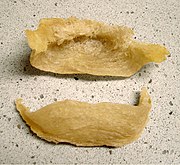Rabu, 16 April 2008
BIRD'S NEST SOUP
-bird's nest soup in Chinesse???
-bird's nest in Egypt???
-bird's nest soup in indonesia???
Bird's nest soup is a delicacy[1] in Chinese cuisine. A few species of swift, the cave swifts, are renowned for building the saliva nests used to produce the unique texture of this soup.
The edible bird's nests are among the most expensive animal products consumed by humans. The nests have been traditionally used in Chinese cooking for over 400 years, most often as bird's nest soup.[2]
Name bird's nest soup in chinese
The Chinese name for bird's nest soup, "yan wo(燕窝)", translates literally as "swiftlet's nest" (yan=swiftlets, wo=nest). When dissolved in water, the birds' nests have a gelatinous texture used for soup or sweet tong sui. It is mostly referred to as "jin wo" unless references are made to the salty or sweet soup in Chinese cuisine.
Harvesting
The most heavily harvested nests are from the Edible-nest Swiftlet or White-nest Swiftlet (Aerodramus fuciphagus) and the Black-nest Swiftlet (Aerodramus maximus)[3]. The white nests and the “red blood” nests are supposedly rich in nutrients which are traditionally believed to provide health benefits, such as aiding digestion, raising libido, improving the voice, alleviating asthma, increasing concentration, and an overall benefit to the immune system.[2]
The nests are built during the breeding season by the male swiftlet over a period of 35 days. They take the shape of a shallow cup stuck to the cave wall. The nests are composed of interwoven strands of salivary laminae cement. Both nests have high levels of calcium, iron, potassium, and magnesium.
Hong Kong and the United States are the largest importers of these nests.[1] In Hong Kong a bowl of Bird Nest Soup would cost US$30 to $100 .[2][4] A kilogram of white nest can cost up to $2,000, and a kilogram of “red blood” nest can cost up to $US 10,000. The white nests are commonly treated with a red pigment, but methods have been developed to determine an adulterated nest.
The nests are traditionally harvested from high up on cave walls. There is some risk to the collectors who stand on bamboo scaffolding that is sometimes hundreds of feet tall and centuries old - with obvious repairs. Over the past twenty years, the demand, the price, and the overexploitation of these nests have increased. The string of people involved in the trade of swiftlet nests has led to the mismanagement of a once sustainable system. Laws governing how the nests are harvested are implemented in each cave[3]. One common system allows the licensed harvesters to take the first nest, allow the bird to build a second nest which she can remain in until her chicks have fledged, and only then is the harvester allowed to take the second nest. Unfortunately, harvesters will take a nest once it is large enough, whether or not eggs or chicks are present. Most caves have one season for harvest but thieves steal nests throughout the year. Because these rules are often broken the swiftlet population has dropped, putting swiftlets on the protected species list.
The penalty for stealing nests is not large enough to deter thieves. Some believe that taking all the nests provides some degree of benefit to the swiftlets because the female will not lay her eggs in an old nest[original research?]. Old nests line the cave walls where new nests could be built. Whether or not this idea of ‘cave cleaning’ benefits the swiftlet population, indiscriminate nest-collection endangers the swiftlet population.
Some bird-nest merchants in Southeast Asia (Vietnam, Indonesia, Thailand, Malaysia etc.) have started to raise and breed the swiftlets in house-like structures. They build the shelters to attract wild swiftlets to build nests in them. Nests of other birds are destroyed with the eggs inside. Over time, the selection process leaves behind a colony of swiftlets that produce the right kind of nest for the trade. "House nests" are priced much lower than "cave nests" due to the risks involved in harvesting the latter.
i’ve been taking the store-bought kind online (e.g. www.geocities.jp/hongkong_bird_nest/index_e.htm of famous branded only of course) which is directly mailed from Hong Kong. this would be at a more affordable price.
Berlangganan Posting Komentar [Atom]
<< Beranda
Berlangganan Komentar [Atom]



